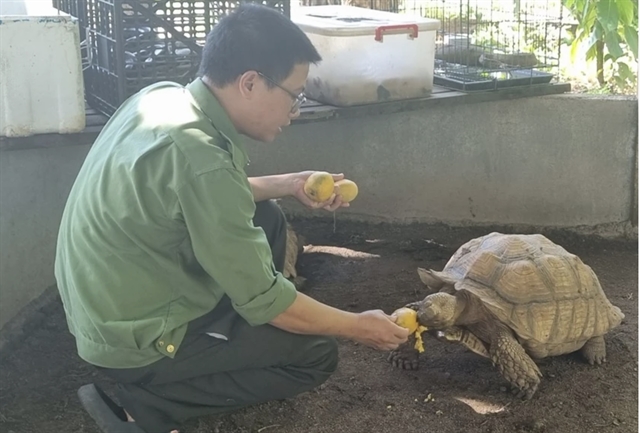 Environment
Environment


|
| Staff from the station feed a turtle which was rescued from a trap. Photo plo.vn |
ĐẮK LẮK – The wildlife rescue station in Đắk Lắk Province has for many years rescued and treated hundreds of wild animals caught in traps or injured.
The wildlife station belongs to the Elephant Conservation Centre, located in a forest area in Krông Na Commune, Buôn Đôn District in the Tây Nguyên (Central Highlands) province.
The wildlife rescue operation was started in April 2021 and has over the years taken in hundreds of wild animals who were being hunted and sometimes left in traps.
The station now is treating and caring for rare and precious wild animals such as pangolins, clouded monitors, binturongs, civets, stump-tailed macaques, rhesus macaques and ferret badgers.
Mai Đức Vĩnh, director of the Đắk Lắk Elephant Conservation Centre told plo.vn that the rescue station is currently caring for more than 70 wild animals some of whom were being traded illegally.
Most of the wild animals brought to the station are severely injured from traps or have been kept in captivity for a long time.
"Many wild animals are seriously injured from traps, suffer from necrosis and need amputation. Some have severe injuries that require multiple surgeries to heal," said staff member Lê Văn Hồng, while pointing to a clouded monitor which has had both legs amputated.
“However, treating wild animals faces many challenges due to the lack of machinery and equipment at the station,” he said.
Many times, Hồng has to take wild animals to veterinary hospitals in Buôn Ma Thuột city for tests, diagnosis and appropriate treatment plans.

|
| Feeding a monkey. Photo plo.vn |
Many wild animals which have been rescued are understandably fearful of humans and thus can become aggressive.
Therefore, the staff must skillfully subdue them and in the case of strong animals, they must be anaesthetised for surgery and treatment, he said.
The enclosures for caring for wild animals are quite rudimentary.
Inside iron frames, staff put branches, ropes and many natural items for the animals to climb and jump on in the hope they will recapture some nostalgia for the forest.
Treating wild animals like pets
According to Hồng, the wildlife rescue station currently has only three staff members. Therefore, they take turns caring for the animals, feeding them, cleaning their enclosures, and guarding against thieves.
Hồng said that after more than two years working with wild animals, he has often shed tears witnessing the severe injuries of wild animals caught in traps.
After the treatment, care and nurturing process, he considers the wild animals like pets.
"Some animals brought here were exhausted, some severely injured. Every time we see a wild animal recover and get healthy, we are very happy,” Hồng said.
“Many times, we go into the forest to find food for them to help them recover more quickly and return to nature."
Mai Thanh Nhân, a rescue staff member who has been working at the station for over six months, said that when he first started, he was scratched and bitten by wild animals. However, after many encounters, he has learned the characteristics of each animal and how to approach them properly at the right time.
Nhân, like other staff members, had to wear long, thick gloves to prevent being bitten or scratched by wild animals, while many wild animals initially refused to eat the available food.
Therefore, Nhân had to venture into the forest to find leaves and wild fruits to care for them.
Nhân's family lives in Cư Jút District of neighbouring Đắk Nông Province, more than 70km from his workplace.
He visits home only once a week, while his remaining time is devoted to caring for wild animals.
According to Nhân, besides rescuing and caring for wild animals, the station's staff regularly come to visit local households to disseminate information to people to dissuade them from hunting or trading wild animals.
Recently, many people voluntarily brought wild animals such as wildcats, jungle fowl, reticulated pythons and turtles to the rescue station.
The Đắk Lắk Elephant Conservation Centre has plans to request about 40ha of land for a wildlife rescue area.
According to officials at the Đắk Lắk Elephant Conservation Centre, expanding the wildlife area will allow the unit to design enclosures following a semi-natural model, creating a suitable habitat to help wild animals recover both health and survival instincts before being released back into the wild. VNS